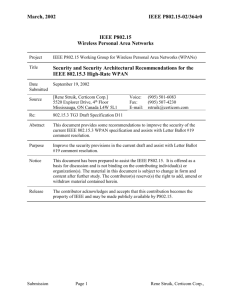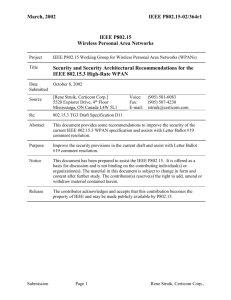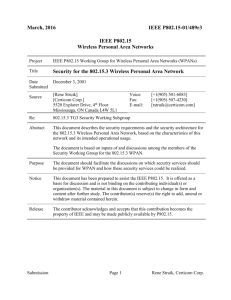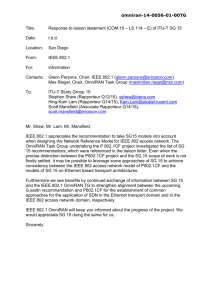Security for the 802.15.3 Wireless Personal Area Network - IEEE
advertisement
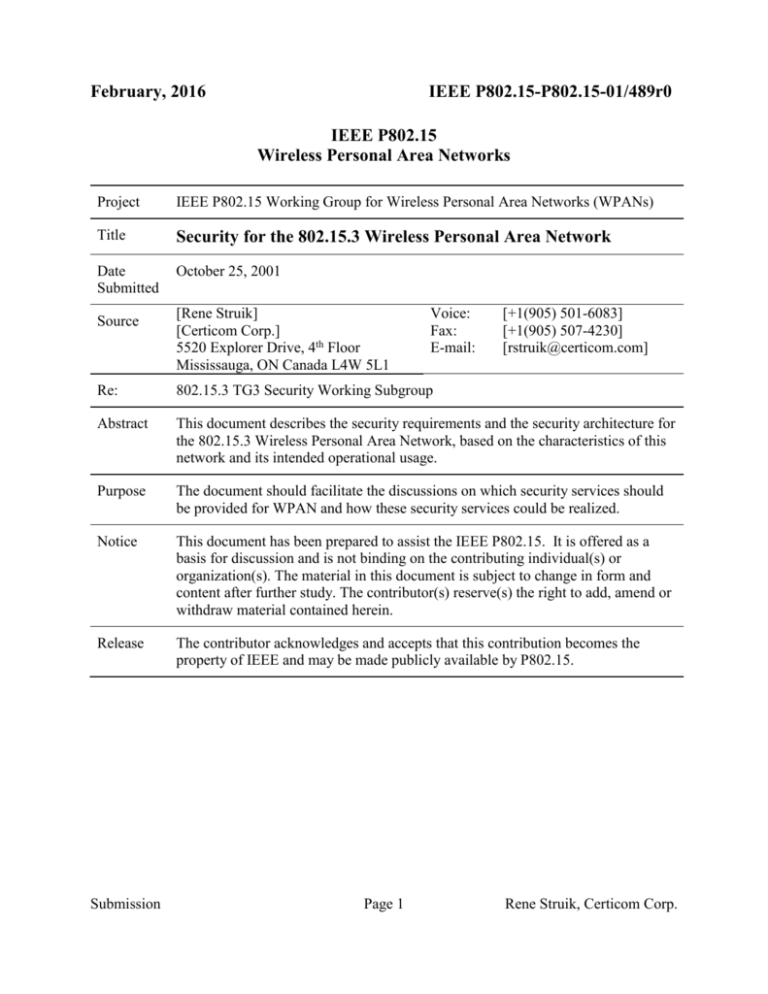
February, 2016 IEEE P802.15-P802.15-01/489r0 IEEE P802.15 Wireless Personal Area Networks Project IEEE P802.15 Working Group for Wireless Personal Area Networks (WPANs) Title Security for the 802.15.3 Wireless Personal Area Network Date Submitted October 25, 2001 Source [Rene Struik] [Certicom Corp.] 5520 Explorer Drive, 4th Floor Mississauga, ON Canada L4W 5L1 Re: 802.15.3 TG3 Security Working Subgroup Abstract This document describes the security requirements and the security architecture for the 802.15.3 Wireless Personal Area Network, based on the characteristics of this network and its intended operational usage. Purpose The document should facilitate the discussions on which security services should be provided for WPAN and how these security services could be realized. Notice This document has been prepared to assist the IEEE P802.15. It is offered as a basis for discussion and is not binding on the contributing individual(s) or organization(s). The material in this document is subject to change in form and content after further study. The contributor(s) reserve(s) the right to add, amend or withdraw material contained herein. Release The contributor acknowledges and accepts that this contribution becomes the property of IEEE and may be made publicly available by P802.15. Submission Page 1 Voice: Fax: E-mail: [+1(905) 501-6083] [+1(905) 507-4230] [rstruik@certicom.com] Rene Struik, Certicom Corp. February, 2016 IEEE P802.15-P802.15-01/489r0 Security for the 802.15.3 Wireless Personal Area Network 1. Characteristics of the 802.15.3 WPAN The 802.15.3 Wireless Personal Area Network exhibits the following relevant characteristics: Communications technology. Data and voice communications is based on radio transmissions operating at 2.4 GHz between static or moving objects that are, typically, at most 10 meters apart. Data transmission rates are above 20 Mbps. Devices. The network is intended for short-range communications between consumer devices including - Computers, PDAs, handheld PCs, printers; - Digital imaging systems, microphones, speakers, and headsets; - Personal and professional video streams (e.g., set-top box output to TV, security camera); - Barcode readers, sensors, displays, pagers, mobile and PCS phones. Each device has a unique Id (the IEEE device address). Personal Area Network (piconet). Communication takes place between a collection of at most 255 devices (nodes) that operate on close distance from one another, in a so-called piconet. Communication can be in one of two forms: peer-to-peer and broadcast. One device, the so-called piconet controller (PNC), has a special role: it takes care of message control and integration with other networks, such as wireless LANs and fixed LANs. Typically, this PNC is a one of the more resourceful devices in the network. The PNC need not be fixed in space and time: PNCs can wander around and be assigned dynamically. Similarly, nodes connect and disconnect in an ad-hoc fashion. Interaction with the outside world. Communication of data between a piconet and other networks, such as wireless LANs and fixed LANs (e.g., IEEE 802.3) takes place via a socalled portal, which communicates MAC service data units back and forth. A comparison between some characteristics of the 802.15.3 WPAN and Bluetooth is given below. Radio frequency 2.4 GHz Data rate Piconet structure 802.15.3 > 20 Mbps 1 controller (PNC), 255 active WPAN nodes Bluetooth 2.4 GHz 1 M symbols/s 1 master, 7 slaves From this table it is clear that the 802.15.3 WPAN operates in a more daunting environment than Bluetooth, in terms of required capabilities. From a security perspective, the operating environments are, however, quite similar. 2. Security Constraints Imposed by the 802.15.3 WPAN The 802.15.3 WPAN imposes the following security constraints: Untrusted devices. Devices are low-cost consumer electronics devices. Secure and authentic storage of keying material in such a device can therefore not be assumed a priori, nor the presence of a high quality random number generator. Submission Page 2 Rene Struik, Certicom Corp. February, 2016 IEEE P802.15-P802.15-01/489r0 Devices with limited capabilities. Devices are low-cost consumer electronic devices. Thus, one has to take into account limitations on computing power, memory constraints, and power drain. This might limit the choice of cryptographic algorithms and protocols, esp. given the relatively high data rate required. Short-range communications only. The communications technology only allows communications between devices that are relatively close to each other. Thus, one cannot rely on on-line centralized key management, since the trusted party might be out of range. Offline involvement of a centralized trusted party, however, can still be realized (This situation is quite similar to that experienced with typical CA services in use at present, where the validity of certificates is checked off-line rather than online, to lower the communication overhead). Short-lived relationships. Devices communicate in an ad-hoc fashion and might never have met before. Thus, initial establishment of trust between these devices needs to be addressed. 3. Security services The security services that need to be provided might include a combination of the following: Mutual entity authentication. Evidence to the communicating devices regarding the identity of their communicating parties. Data Integrity. Assurances that communicating data and control strings have not been altered in transit. Confidentiality. Guarantee that communicated data remains private to the parties that knowingly partake in communications. Non-repudiation. Binding of a communicating device to its commitments and/or actions, such that these cannot be denied later on. Anonymity. Non-disclosure of the identity of communicating parties to any third party. Availability. Assurances as to the continuity of service delivery (here: security services). The actual security services that are required (or desirable) depend on the actual application at hand. A short discussion exemplifying the need for a (combination of) security service(s) follows. Confidentiality of data is required to prevent exposure of potentially sensitive data, such as Pay TV signals and personal data synchronized between a PDA and another device trusted by the PDA user. Integrity is needed to ensure that data is received accurately and completely, such as personal data and video streams communicated by a security camera. Source authentication is required to assure the receiving device as to the true identity of the sending device, such as a PDA or, again, a security camera. Destination authentication is required to assure the sending device as to the true identity of the recipient, such as the computing devices a PDA synchronizes to and TV monitor and speakers with copy protection circuitry aboard a set-top box or other home entertainment box communicates to. Non-repudiation is required in settings where denial of previous commitments should be prevented, such as ordering Video-on-Demand services, software upgrades of digital TV capabilities, and downloading of music. Anonymity might be required to prevent linkage of data trails to individuals, such as to respect privacy of individuals or simply to comply with privacy laws. Availability is desirable to ensure quality of service. Submission Page 3 Rene Struik, Certicom Corp. February, 2016 IEEE P802.15-P802.15-01/489r0 Some of the security services cannot be met in the 802.15.3 WPAN setting or are more appropriately realized elsewhere. Availability assurances cannot be given, since the radio signal transmissions in a piconet can easily be overruled by powerful jamming equipment. The requirement for anonymity might conflict with the need for entity authentication in networks where devices might never have met before. Non-repudiation might be more appropriately realized outside the MAC (Medium Access Control) and PHY (Physical) layer, e.g., at the application level. The same remark might apply to some of the other security services, e.g., confidentiality and data integrity. All security services ultimately depend on the availability of some secret piece of information at every user device and, hence, require a trusted component that allows the secure processing1 and storage hereof. Moreover, many cryptographic operations require a high quality source of randomness, to prevent attacks that exploit the predictability of part of the protocol messages to derive information on the secret key. The availability of a trusted processing and storage facility and some source of randomness might, however, not be a given in low-cost consumer devices. Without these, no cryptographic security can be provided. 4. Trust management The security services mentioned in §3 (apart from availability) could all be realized using standard cryptographic techniques, provided trust management between devices is implemented correctly. Trust management comprises initial trust establishment and trust maintenance. A short discussion follows. 4.1 Initial Trust Establishment Devices communicate in an ad-hoc fashion and might never have met before. Prior to communications, a trust relationship needs to be establishment. This can be done in either of the following ways. 1. Without involvement of a trusted party. Parties can establish a common initial secret by communicating A secret piece of information (PIN). This has to be realized via non-cryptographic means, e.g., by communicating the key between devices using a wire or by key transport with human involvement (which requires a means for inputting data on either device). The key transport should be realized ensuring confidentiality and authenticity of data. Both methods are quite cumbersome and inconvenient. An authentic piece of information (public strings). This has to be realized via noncryptographic means, e.g., by communicating the strings between devices using a wire or by transport of the strings with human involvement (which requires a means for inputting data on either device). The transport of strings should be realized ensuring the authenticity of the data. Both methods are quite cumbersome and inconvenient. A different method might involve wireless communications of the data, if one could realize this in such a way as to prevent alteration of the signal in transit. At present, we do not know whether or not one can realize the latter in the 802.15.3 WPAN setting. 1 Without leakage of keying material by observing the physical characteristics of the computing device (power consumption, timing info, and so on). Submission Page 4 Rene Struik, Certicom Corp. February, 2016 IEEE P802.15-P802.15-01/489r0 Neither of the two methods provides cryptographic assurances as to the true identity of the devices that want to communicate. The identity must, therefore, be verified using noncryptographic methods and, most likely, would require human intervention (e.g., ‘confirmation button’ and the-like). 2. With involvement of a trusted party. Parties can establish a common initial secret by engaging in a key establishment protocol (cf. §A.1) based on Symmetric key certificates. This requires the processing of the certificates and the certificate key of the trusted party that created these certificates to be securely embedded in the device (and it to be user-inaccessible). Note that compromise of the trusted device’s symmetric key on a particular device compromises all devices that use this key. Public key certificates. This requires the public key of the trusted party that created the certificates to be stored in the device maintaining the authenticity hereof. Note that compromise of the trusted device’s public key on a particular device only compromises that device. Both methods provide assurances as to the true identity of the devices that want to communicate (provided this information is incorporated in the certificates). The initial distribution of keying material could be realized by any of the out-of-band methods mentioned above (cf. Item 1) or at the production or personalization stage of the devices. From the discussion above it is clear that involvement of a trusted party is required, since otherwise there are no assurances whatsoever as to the true identity of the communicating parties. Furthermore, public key certificates are to be preferred over symmetric key certificates, since these limit the impact of key compromise to compromised devices only and since these impose less of a burden on the required trust to be embedded on the (low-cost) devices themselves. Finally, note that the creation of public key certificates is an inherently off-line activity and can therefore be realized in a short-range communication environment. 4.2 Trust Maintenance Trust maintenance compromises of implementing the typical stages of the public key life-cycle. It includes Key revocation. This refers to invalidation of public keying material due to key compromise, key loss, or expiration of the key(s) in question. Key renewal. This refers to the issuance of new public keying material (see also §4.1, initial trust establishment). Key registration. This refers to the maintenance of an authentic list of issued public keys. [MORE TO BE ADDED, DEPENDING UPON ARCHITECTURAL REQUIREMENTS] 5. Security Services [TO BE COMPLETED] 6. Access Control Access control within a particular piconet involves procedures that specify the consequences of the following events for the parties involved: Introduction of a new device to a piconet. Submission Page 5 Rene Struik, Certicom Corp. February, 2016 IEEE P802.15-P802.15-01/489r0 Removal of a device from a piconet. Change of a Piconet Controller (PNC). First, we describe the security attributes of the parties involved in a piconet. Based upon this role model, we specify the impact of the events listed above on each of these parties. 6.1 Role Model One can distinguish the following security-relevant entities. Trusted Party. This entity is the sole source of trust management. It provides each device with initial keying material and assumes all actions necessary for maintaining this keying material. Piconet Controller (PNC). This entity is a piconet device that, solely or additionally, takes care of message control and integration with all external networks (with respect to the piconet). This entity does not assume any security responsibilities. Ordinary Piconet Device. This is an ordinary communicating device that is part of the piconet. The device is responsible for the secure storage of its keying material. Rationale: The piconet controller (PNC) need not be fixed in time and space. Since the device that is assigned the role of PNC might vary over time, it is not convenient to have it assume any trusted party functionality (for otherwise, trust needs to be established over and over again, at each change of PNC). The trusted party is assumed to be the sole source of trust, since it is a party that is external to the network and might have facilities that are deemed necessary for proper trust management (e.g., secure key generation facilities, proper authentic storage of keying material, availability, etc.). NOTE: During the discussion of October 23, 2001, it was suggested to limit the number of devices that could assume the role of piconet controller. This might enable the amalgamation of the role of the trusted party and that of the PNC. Extreme caution is advised, however, since the trust in security services ultimately depends on the trust in the PNC. 6.2 Security Relevant Events 6.2.1 Introduction of a New Device to a Piconet This involves both the would-be piconet device and the piconet controller. The procedure might, e.g., involve the following steps: The PNC sends a nonce at regular time intervals (e.g., every 100ms). A device that wants to join the piconet, signs the latest nonce received, using its private key, and sends the triplet consisting of this signature, the nonce, and its certificate to the PNC. The PNC verifies whether the validity and timeliness of the signature. Upon correct validation, it awards the device membership of the piconet (depending upon availability of ‘slots’ and, e.g., credentials, such as ‘being a compliant device’). The PNC maintains an upto-date list of all devices that legitimately comprise the piconet. Submission Page 6 Rene Struik, Certicom Corp. February, 2016 IEEE P802.15-P802.15-01/489r0 Note that the PNC assumes no security relevant functions. The signature validation is only aimed at blocking scarce network resources to devices that do not pass this test or, somehow, do not comply for other reasons. 6.2.2 Removal of a Device from a Piconet This involves a step similar to the one described in §6.1.1. Canceling membership depends on proper verification of a signed request here as well. Cancellation might be delayed awaiting proper completion of an atomic action. Proper cancellation of keys shared with remaining devices needs to take place. 6.2.3 Change of Piconet Controller This involves the transfer of the message control data from one PNC to another. Transfer is subject to potential delays awaiting proper completion of an atomic action and ‘checking of credentials or sufficient resources’ of the would-be PNC. 6.2.4 Key Establishment between Two Piconet Devices This involves the establishment of a shared key between two piconet devices, using the resource facilities provided by the piconet controller. The actual identity of the sharing device is of utmost importance here (e.g., ‘non-compliant devices’ might introduce violation of access control policies on the content level). [TO BE COMPLETED] 6.2.5 Invalidation of a Key shared by two Piconet Devices This involves the cancellation of a shared key between two piconet devices, possibly using the resource facilities provided by the piconet controller (in case the sharing device is notified). The actual identity of the sharing device is of utmost importance here (e.g., ‘non-compliant devices’ might introduce violation of access control policies on the content level). [TO BE COMPLETED] APPENDIX A – CRYPTOGRAPHIC BUILDING BLOCKS A.1 Key Establishment Protocols A.1.1 MQV Protocol The MQV key establishment protocol provides for unilateral or mutual entity authentication and key agreement. The protocol combines Diffie-Hellman-like key agreement with implicit signatures. Features Standardization. The MQV protocol is an ANSI 9.63 Standard, an IEEE P-1363 Standard, the ISO 15946-3 Standard, and will become a FIPS Standard soon. Independent scrutiny. The National Security Administration (NSA) has publicly stated that this Elliptic Curve Diffie-Hellman (ECDH) key agreement protocol is the most well-studied key agreement protocol so far. Submission Page 7 Rene Struik, Certicom Corp. February, 2016 IEEE P802.15-P802.15-01/489r0 Proven practicality. The University of Bristol Mobile and Wearable Computing Group has successfully implemented the MQV Protocol on a so-called ‘cyber-jacket’. [TO BE COMPLETED] A.2 Encryption Algorithms A.2.1 Advanced Encryption Standard [TO BE COMPLETED] A.3 Certificates A.3.1 Implicitly Certified Public Keys Implicitly certified public keys provide an alternative for transporting public keys using publickey certificates. The main idea is that it is not necessary to store public keys as such; storage of related data instead, plus an efficient procedure for reconstructing public keys from these, suffices. With implicitly certified public keys, the public key is reconstructed based upon the identity of the device the public key is associated with and the previously mentioned related data. In addition, evidence regarding the authenticity of the reconstructed public key string is provided. Features Low bandwidth. The string that allows the reconstruction of each entity’s public key has roughly the same size as the public key itself, thus saving on required bandwidth, when compared to the situation where one has to communicate a ‘classical’ public key certificate (which would at least double the size). Same verification overhead. The reconstruction of the device’s public key has roughly the same computational overhead as that associated with verification of the validity of a ‘classical’ public key certificate. No need for certificate directory. The authenticity of reconstructed public keys can be verified based on the public reconstructing data only, thus obviating the need for a database with public key certificates. Proven practicality. Canada Post [3] uses implicitly certified public keys in their revenue collection system. A similar system using implicit certificates is presently under consideration by US Post. [TO BE COMPLETED] APPENDIX B – SYSTEM CONSTRAINTS2 B.1 Network Characteristics The following network characteristics apply: Data throughput. The data transmission rate is at least 20 Mbps. Control data latency. Control data should not notably slow down the system. Acceptable time latencies: Based on ‘Ari Singer, IEEE P802-15_TG3 Security Rationale – Draft 0.1, October 18, 2001’ and the System Specification [1]. 2 Submission Page 8 Rene Struik, Certicom Corp. February, 2016 IEEE P802.15-P802.15-01/489r0 - For key exchange: 2 seconds (based on two-party protocol), plus time till a time-out. - For changing the piconet controller (PNC): [UNKNOWN] - For introduction of a device to a piconet: [UNKNOWN] - For disconnection of a device from a piconet: [UNKNOWN] - For key initialization for an encryption algorithm: [UNKNOWN] Data characteristics. The data size is unclear (big chunks, small packets)? The ordering between packets is unclear (Do these arrive in order, integrity ‘across’ packets?). Note: Packet size does not appear to be a significant constraint, particularly for control packets (as opposed to data packets): the packet size is roughly 1500 bytes and could allocate as much as, say, 500 bytes hereof for security; the packet size could be increased to as much as 2K B.2 Device Characteristics The following device characteristics apply to all devices in a piconet: Computational power. The devices have very little computational power. It is expected that they can run at a clock rate of approximately 2 times the data rate (e.g., for 20Mbps communication, we can assume the device can run at about 40 MHz) with only a small portion of that available for cryptographic computations. Available RAM memory. Devices are expected to have 20-30K RAM available for cryptoalgorithms. APPENDIX C – GENERAL REQUIREMENTS The following general requirements apply: Inter-operability issues. [TO BE COMPLETED] Standardization issues. Standardization of security methods (e.g., protocols and algorithms) is highly desirable, although this might not be possible due to the unique requirements imposed by the 802.15.3 WPAN. The academic community should have subjected the cryptographic algorithms and protocols to sufficient peer review, in order for these to be considered for use within the WAP framework. Moreover, the design principles should be published. [TO BE COMPLETED] 5. References [1] Draft Standard for Information Technology – Telecommunications and Information Exchange Between Systems – Local and Metropolitan Are Networks Specific Requirements – Part 15.3: Wireless Medium Access Control (MAC) and Physical Layer (PHY) Specifications for High Rate Wireless Personal Area Networks (WPAN), Draft P802.15.3/07, May 2001. [2] Greg Rasor, General Overview [of the 802.15.3 WPAN], August 5, 2001. [3] L.A. Pintsov, S.A. Vanstone, Postal Revenue Collection in the Digital Age, Technical Report CORR 2000-43, CACR, University of Waterloo, 2000. Cf. http://www.cacr.math.uwaterloo.ca Submission Page 9 Rene Struik, Certicom Corp.
